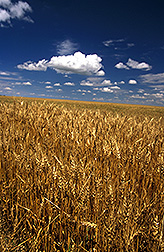This page has been archived and is being provided for reference purposes only. The page is no longer being updated, and therefore, links on the page may be invalid.
| Read the magazine story to find out more. |
|
|
No-Till, Summer Fallow Stores Water in Central Great Plains
By Don ComisJanuary 11, 2011
Storing just one inch of water in an acre of soil is worth $25 to $30 per acre. That gets the attention of Central Great Plains farmers served by U.S. Department of Agriculture (USDA) researchers.
Soil scientist Merle Vigil and his colleagues at the Agricultural Research Service (ARS) Central Great Plains Research Station at Akron, Colo., calculated this by using 10-year average crop prices in equations they developed to relate crop yields to stored water levels. ARS is USDA's principal intramural scientific research agency, and this research supports USDA's commitment to agricultural sustainability.
Four to six passes with various tillage equipment to kill weeds over 14 months of leaving land idle or fallow result in a loss of 3 acre-inches of water to evaporation. Those six passes also cost $24 to $48 an acre in fuel and labor costs. Add that to the cost of water lost, and you have $99 to $138 an acre that never makes it into the farmers' pockets.
Plains farmers traditionally grow wheat only every other year, leaving fields fallow in between, because most years there isn't enough precipitation to grow wheat annually.
The scientists are approaching their 20th year of a major project determining which alternative crops farmers could add into a rotation with wheat to eliminate, or at least reduce the frequency of, fallow fields.
The scientists have shown that farmers can prevent much of that loss-and store more precipitation-just by eliminating tillage. And by combining no-till with intensive crop rotation management, farmers can capture even more of the precious 14 to 18 inches of rain or snowmelt that may occur each year in various parts of the Central Plains.
Their tests of various crops showed that the most profitable rotation is growing no-till wheat one year and no-till millet the next. An economic analysis based on a hypothetical 160-acre farm showed this rotation could increase a farmer's net income by as much as $1,300 a year, compared to a no-till wheat-fallow rotation.
Read more about this research in the January 2011issue of Agricultural Research magazine, available online at: /is/AR/archive/jan11/rotations0111.htm.
This research was published in Agronomy Abstracts and presented at the 2010 annual meeting of the American Society of Agronomy, Crop Science Society of America, and Soil Science Society of America.

